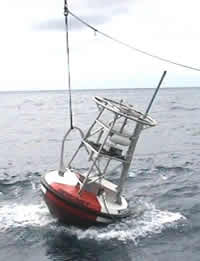| |
Teacher Logbook - NOAA Ship Ron Brown
| |

RAS at Cloud vent, marker-N6, where it
will be deployed for NeMO
Net the next year.

After the RAS was placed at Cloud vent on dive R630, the NeMO Net
buoy was deployed from the Ron Brown. |
|
Jeff Goodrich's Sealog:
Axial Volcano - 1998 lava flow
July 28, 2001
The scientists
are gathering mounds of data about the dynamic nature of
Axial
Volcano and it's hydrothermal vents. However, for a deeper understanding
of
this
complex tectonic system, snapshot science really doesn't cut it. Continual
monitoring or monitoring during eruptive events is ideal. This process
has
already been started. In 1998 a rumbleometer, a device that measures
vertical
displacement and temperature, detected inflation and deflation of the
volcano
during the eruption. MTR's and HOBO's (temperature recorders) monitor
the
temperature of diffuse and hot vents on an ongoing basis. Vent chemistry
is
the
piece of the puzzle that, until now, has only been monitored during NeMO
cruises. With the RAS (Remote Access Sampler) and the NeMO Net buoy,
real-time
chemical data will be gathered when the scientists feel it's needed.
Scientists deployed the RAS at Cloud vent last night and spent a lot of
time
checking and double checking how and where they wanted it positioned,
its
alignment, and if it was able to communicate. Today, the second part of
the
NeMO
Net system was deployed. The NeMO Net buoy will receive messages
acoustically
from the RAS and send the message, via the LEO (Low Earth Orbiting)
satellite
system, to the Pacific Marine Environmental Laboratory in Seattle. It
allows
two-way communication for desktop-to-seafloor chemistry. Chemical
oceanographer
Dave Butterfield can specify when he wants a sample taken and in which
of
the 48
bottles on the RAS he wants to store it. A default mechanism triggers
the
RAS to
sample one bottle per week and a chemical scan of temperature, pH, and
H2S
(hydrogen sulfide) every three days. The RAS has taken the chemistry lab
to
the
ocean floor.
The NeMO
Net buoy is tethered to the seafloor, held in place with a railroad-car
wheel. It restricts diving within 2 km of its vicinity due to a risk of
tangling ROPOS in it's tether so scientists were busy last night finishing
up work around the Cloud vent area. Our few remaining dives are limited
to other areas in the caldera. The NeMO Net/RAS is another step toward
real-time monitoring of the vents on a continual basis. Perhaps in the
future the sampler won't be stationary. An autonomous underwater vehicle
(AUV), stored in an underwater garage, will be controlled from scientists
on shore. It will move from vent to vent, sampling and uploading data
to the web for all to see.
|
|

